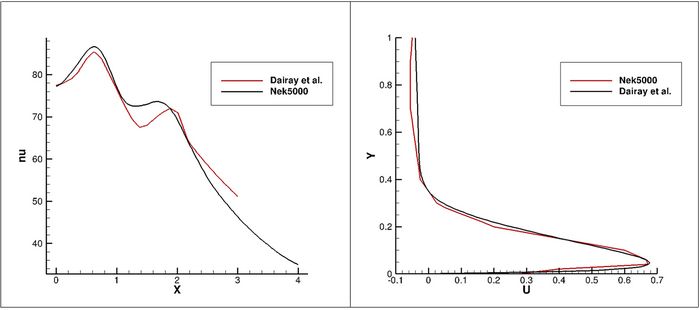ENGINEERING AND CFD
Direct Numerical Simulation of an Impinging Jet at Re=10,000
Principal Investigator:
Franco Magagnato
Affiliation:
Institute of Fluid Mechanics, Karlsruhe Institute of Technology
Local Project ID:
Imp_DNS
HPC Platform used:
Hazel Hen and Hawk of HLRS
Date published:
In many industrial applications such as cooling of gas turbine blades, machine components and electronic equipment, drying and air-cooled heat exchangers, the understanding of flow and heat transfer in impinging jets is of central significance.
The heat transfer in the stagnation region of an impinging jet at given jet to distance ratio, Re-number and Temperature ratio depend on the turbulent inflow characteristics. Using Direct Numerical Simulations with the spectral element code Nek5000, the Nusselt number distribution as well as the turbulent statistics close to the heated wall have been investigated.
We have made calculations with different inlet velocity profiles (top head profile, fully developed flow) as well as variable turbulence quantities. Using synthetic inflow boundary conditions from Poletto et al. (2015) called Divergence Free Synthetic Eddy Method (DFSEM) variable Reynolds stresses can be investigated. Additionally the classical precursor method has been used for fully developed flow field’s simulation. The mentioned inflow method has been compared with the precursor simulation.
The investigated configuration is a classical impinging jet flow with a nozzle-to-plate distance of two pipe diameters. The Reynolds number based on diameter of the nozzle D and the bulk velocity Ub was

Since we wanted to compare our results with the numerical results obtained from Dairay et al. (2015), we used a flow domain as close as possible to them. In contrast to them, we formed the computational domain in a cylindrical shape instead of a rectangle shape, which additionally extended 24D in the radial direction instead of 12D. The reason for that was that we did not want do apply a specialized boundary condition at the outlet of the flow domain. They applied the so-called fringe method. This technique consists in the addition of a volume force in the source term of the Navier-Stokes equations. In order not to disturb the flow field at the outlet, Dairay et al. had to prescribe the velocity distribution at this station according to the fringe method. This enabled them to use a smaller flow domain. In our case, we could apply a classical outlet boundary condition with freestream static pressure. The results showed a negligible influence at the outlet. Dairay et al. used their own synthetic inlet boundary condition, which is quite different to the DFSEM used with Nek5000.
The configuration used a confinement plate right at the nozzle outlet in order to simplify the computational domain. Without the confinement plate, the entrainment flow from the surroundings had to be prescribed precisely.
The inflow temperature was T=300 K and on the heated wall a constant heat flux density φp>0 was set, while on the confinement plate a constant wall temperature of T=300 K was used. At the walls, the no-slip boundary condition are applied.
The mesh consists of about 8.2*108 points in the finest mesh used (see figure 1).
In figure 2, the turbulent flow field in the symmetry plane is shown. The comparison of the Nusselt number at the impinging wall with the DNS of Dairay et al. is in good agreement with it, considering the different inlet profiles used by the two calculations. The mean velocity distribution evaluated at the radius r/D=2 shows an even better agreement with Dairay, since the prediction of mean values is generally easier predictable with DNS.
In the computation of these results, we have used up to 8320 AMD-EPYC 7742 cores of the HP Apollo (Hawk) at the High-Performance Computing Center (HLRS) Stuttgart. The open source code Nek5000 is parallized with the MPI-2 software. The computational time for one DNS calculation using about 830*106 points was about 80h for the averaging process. The load balancing was at about 99% because Nek5000 is an unstructured code. The parallel efficiency was also very good. Since in Stuttgart the communication is done with the InfiniBand HDR200 node-node interconnection, the parallel efficiency was close to 96%. This very good parallel efficiency could only be obtained because the amount of output was reduced to a minimum. It is desired that the amount of output data should be increased so the read/write performance of the code needs to be improved in the near future.
Publications:
[1] Paul Fischer, James Lottes, Stefan Kerkemeier, Oana Marin, Katherine Heisey, Aleks Obabko, Elia Merzari, Yulia Peet, Ronald Rahaman, NEK5000 User Guide, Argonne National Laboratory, (2016).
[2] T. Dairay, V. Fortune, E. Lamballais and L-E. Brizzi. Direct numerical simulation of a turbulent jet impinging on a heated wall. J. Fluid Mech., vol. 764, pp. 362-394, (2015).
[3] R. Poletto. Divergence free development of the synthetic eddy method in order to improve synthetic turbulenc for embedded les simulations, PhD Thesis, The University of Manchester, (2015).
Acknowledgements
The present work is a part of the subproject B2 of the Collaborative Research Centre (CRC) 150 – “Turbulent, Chemically Reactive Multi Phase-Flows near Walls”, sub-project B02. The project is supported by the German Research Foundation.
Scientific Contact:
Dr.-Ing. Franco Magagnato
Institute of Fluid Mechanics
Karlsruhe Institute of Technology
Kaiserstrasse 12, D-76131 Karlsruhe (Germany)
e-mail: franco.magagnato [@] kit.edu
Local project ID: Imp_DNS
September 2020


